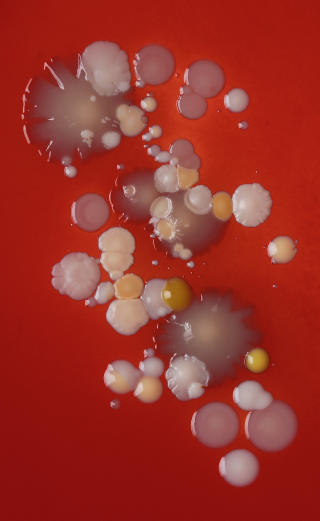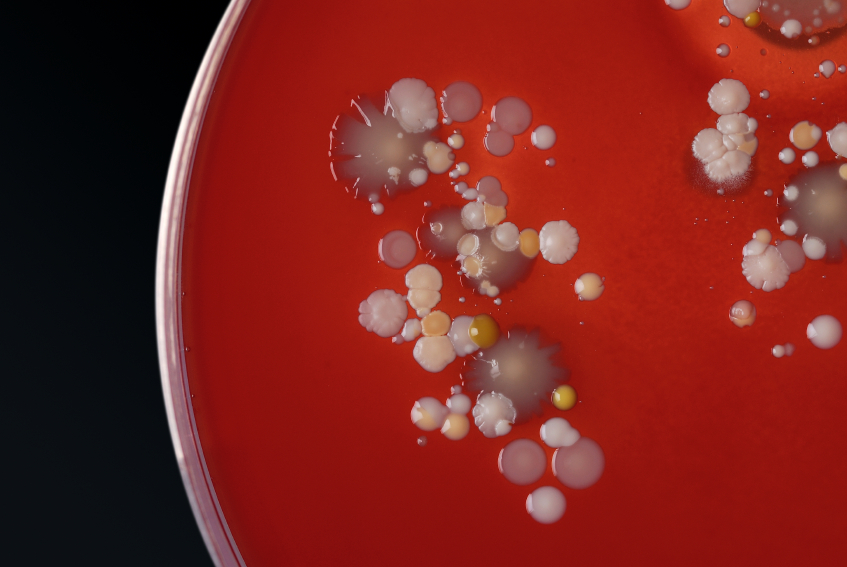Coffee Stains Test Universal Equation
Drops of coffee on a table dry into dark rings, but fluids with less-spherical particles suspended in them dry as filled-in circles. The research team that discovered this distinction now demonstrates a new surprise—that the motion of the particles during drying provides the first easily-tuned example of an equation that appears in phenomena as diverse as bacterial growth and burning paper. In Physical Review Letters they describe watching drying drops of fluid under a microscope and measuring the distribution of the particles during the process. The experiments provide a rare direct test of the so-called KPZ equation, which has been difficult to verify in other phenomena.
The brown outlines left behind by spilled drops of coffee were explained in 1997 [1]. As water at the drop edges evaporates, remaining water flows outward from the center to replace it, carrying the brown coffee particles and leaving a dark ring when the liquid is gone. Last year, Arjun Yodh of the University of Pennsylvania and his colleagues showed that they could block the formation of the ring-shaped deposit by adding ellipsoidal particles to the mix [2]. Unlike spheres, these particles often stick together due to interactions with the liquid surface near the shallow drop edges. So they tend not to drift all the way to the drop’s edge before sticking to other particles and forming clumps. As a result, the thickness of the ring increases, and the inner edge of the ring advances rapidly toward the center during the drying process.
The phenomenon of this advancing inner edge caught the eye of Massachusetts Institute of Technology (MIT) mathematician Alexei Borodin, who suspected it was an example of the Kardar-Parisi-Zhang (KPZ) equation [3]. This equation describes a front gradually advancing, where the rate of motion at each location is affected by randomness as well as by the local curvature of the front. It may describe a burn front moving through cigarette paper, the edge of growth in a bacterial colony, or the border between order and disorder in a liquid crystal. But it has been difficult to demonstrate many of the predictions of the universal equation, as they require a well-controlled and tunable experimental system to test.
Yodh’s experimental team collaborated with Borodin to test his hunch. They used their previous techniques for observing drying drops of fluid and developed new techniques to count the deposited particles and compare with the KPZ equation. They mixed drops of water with -micron-wide plastic spheres or similar-sized ellipsoids and watched them evaporate from a glass surface through a microscope. The team divided the edge of each drop into sectors, or “columns,” and counted the number of particles that streamed into each as the water evaporated.
For the spheres, the particles fell in a so-called Poisson distribution, as one would expect for independent, random particles, such as rain hitting the ground or photons passing through a box. This distribution accounts for the rings from dried drops of coffee. The ellipsoids tended to stick to neighboring particles in the next column before reaching the edge of the drying drop, which increased the rate at which particles accumulated in each column. Analysis showed that ellipsoids did, indeed, fit the predictions of the KPZ equation.
Running the experiment a third time, with rods instead of ellipsoids, made the particles even stickier and displayed yet a third growth pattern. In this case, columns already rich with particles attracted even more and grew very quickly, creating big spikes surrounded by flattish regions with very few particles. This pattern fit a form of the KPZ equation called KPZQ, a version that usually describes a growing crystal interface hitting an obstacle. But in this case, something new is going on. “The KPZQ region is crying out for more experimental work to understand it,” says coauthor Peter Yunker, a graduate student of Yodh when he did the research.
“Tweaking a single variable and observing three different universality classes,” or mathematically distinct patterns, is very unusual, says Tim Halpin-Healy of Columbia University in New York. Tom Lubensky of the University of Pennsylvania, who was not involved in the research, is also intrigued. “The nice thing about this work is that it is in a surprising place,” he says. “Nobody ever expected that an evaporating colloid would be an interesting place to look for the physics of interfacial growth.”
–Kim Krieger
Kim Krieger is a freelance science writer in Norwalk, Connecticut.
References
- R. D. Deegan, O. Bakajin, T. F. Dupont, G. Huber, S. R. Nagel, and T. A. Witten, “Capillary Flow as the Cause of Ring Stains from Dried Liquid Drops,” Nature 389, 827 (1997)
- P. J. Yunker, T. Still, M. A. Lohr, and A. G. Yodh, “Suppression of the Coffee-Ring Effect by Shape-Dependent Capillary Interactions,” Nature 476, 308 (2011)
- M. Kardar, G. Parisi, and Y-C. Zhang, “Dynamic Scaling of Growing Interfaces,” Phys. Rev. Lett. 56, 889 (1986)





